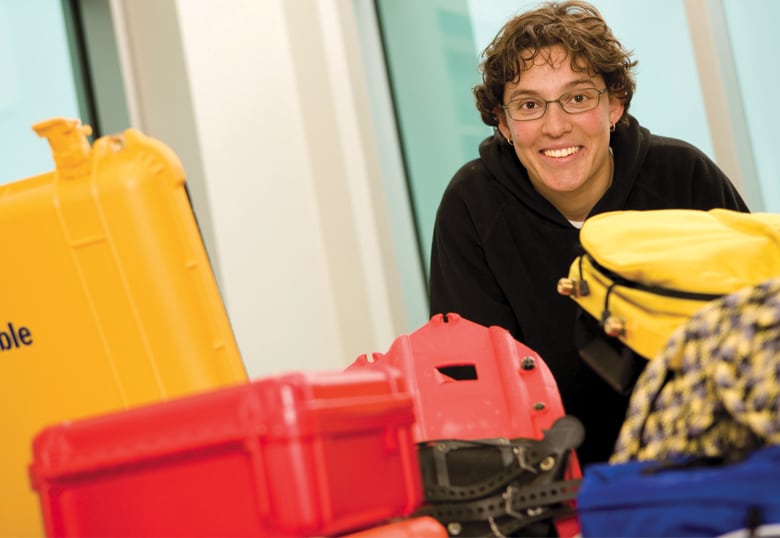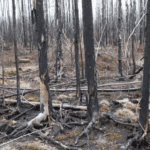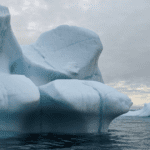At Canadian Science Publishing (CSP), we publish Sarah Boon’s Women in Science blog series, first started in July 2014, and now with a dozen posts featuring Canadian women in science. Promoting diversity in science is a key priority for CSP and we are always working to improve our methods. Why is it important to feature women in science, particularly Canadian women in science? To answer this question and more, today we turn the interviewer into the interviewee and chat with scientist and writer, Sarah Boon.

Image: University of Lethbridge
Why were you interested in starting a series that profiles women in science?
I’m inordinately interested in the details of people’s lives, the backstory that never quite makes its way into the public sphere (for this reason I also did a series on women environment writers on my blog). I think as a society we’re far too focused on outcomes: the great job, the high-impact journal article, the stellar scientific reputation…we forget that the path people follow to reach those outcomes is just as important.
Back in 2013 I’d read a guest post on the Dynamic Ecology blog in which Carla Davidson, a microbiologist from Calgary, wrote about the career path that led to her current (non-academic) position. I thought her story was fascinating, as it incorporated a range of factors: education, life choices, and luck. The post also struck a chord: Davidson wrote that, because of her varied research background, she was often accused by other academics of a lack of focus; when she created her own business, however, she managed to capitalize on that so-called weakness. I felt the same way. Before I left academia due to illness, my curiosity about a broad range of topics in my field (cold regions hydrology) meant that I was often accused of the same lack of focus.
It occurred to me that, if Davidson’s post had such an impact on me, it was likely also relevant to others. Since I’d just been asked to write for the Canadian Science Publishing blog, I decided that interviewing Canadian women in science would be part of my beat. I wanted to share with readers these women’s background stories, the details that you don’t hear about when you read that someone just became a Dean, or started their own business, or rose to the VP position of a prestigious company. I wanted people to be able to see *how* they did it, what they were thinking, and what challenges they met along the way. I focused on women in science because I think our career paths are still fairly opaque compared to those of men in science. I also thought it would help both women thinking of science careers, and women well into their science careers, to be able to read these stories.
You’ve been writing the Women in Science series for about a year and a half now. What have you learned over this time about the achievements of Canadian women in science?
Most of the women I’ve interviewed have been in environmental or biological sciences of some kind. While this is a function of the science community I’m part of, in future posts I’d like to showcase women from other disciplines as well (engineering, chemistry, math, physics, etc.). So please send your suggestions of potential interviewees!
It should come as no surprise that the series thus far has shown that Canadian women fill a variety of science-related positions, and make huge contributions to science across a range of environment and life-science related disciplines. I’ve interviewed federal and provincial government scientists, academics, women in both industry and non-profit organizations, and women who are working as consultants. Whether they’re providing entrepreneurial training like Usha Srinivasan at MaRS, curating the Earth Sciences Section of the Royal Alberta Museum like Alwynne Beaudoin, mitigating land use change impacts on aquatic ecosystems like Deborah Martin-Downs, or sharing open data science in ecology like Christie Bahlai—women are involved in all aspects of the scientific endeavour and making significant contributions to their fields. They cannot be ignored!
What have been some of the greatest, collective lessons from the twelve women you have profiled? Any advice that really stands out?
The most important lesson that the series has taught me is that there is no one, single scientist career path—whether or not you’re a woman. Many of my subjects bounced between academia and consulting, or government science, and back again, sometimes with some extended world travelling in between.
It’s also not necessary that you decide as a child that you’re going to be a scientist—many of my subjects practically fell into their research field during their undergraduate degrees, rather than planning it in advance.
Many of the women talked about the importance of having excellent mentors who sparked their interest in a particular research topic or helped them through a particularly tough time.
All of the women spoke of doing what interests you, regardless of what people—or stereotypes—might try to tell you about your ability to do it.
Are there any challenges for women in science that have been echoed throughout your various interviews?
I think the biggest challenge that each interviewee noted was the effect of stereotypes. Rita Winkler addressed the problem explicitly when she said, “Some people expect women to react in certain ways, do certain things, and so on, all of which are entirely up to each individual scientist. It’s hard work to keep from being cast as something that you’re not.”
All of the interviewees have overcome challenges of some sort to reach their current position—stereotypes being a key aspect of those challenges. However, many of the women were quick to note that these challenges stem from societal problems, and as such aren’t limited solely to science careers. While this is true, I think it’s particularly useful that interviewees share their personal challenges, so that up and coming women in science are aware of the potential difficulties they may face, and can learn from women who have gone before them.
Several interviewees also focused specifically on the challenges of fieldwork: how to manage extensive fieldwork campaigns when you have children, and the experience of being, in many cases, one of only a few women in a field situation. This mirrors some of the work done by Kate Clancy and her colleagues on women’s field experiences in anthropology.
Do you think it is getting better for women in science and even academia as a whole? What work is left to do?
The biggest thing that interviewees noted was that, in academia at least, the rules around maternity leave have improved significantly, and tenure decisions are more accommodating of maternity leaves than they used to be. The climate for women in science also seems to have improved overall—as Alwynne Beaudoin noted, “it’s been a few years since I’ve heard anyone say ‘Oh, she only got that job because she was a woman.’”
But there is still work left to do. Imogen Coe noted in the most recent post that an incident in her department made her “wonder whether her academic colleagues have a real understanding of the importance of equity, diversity, and inclusivity.”
Women are still underrepresented in the upper levels of academia (full professor, administration) and of industry (VPs, CEOs). In many workplaces, women are still paid less than men—a divide that some institutions have worked hard to bridge. The University of Wisconsin-Madison, for example, has a process they follow to ensure women and men receive equal pay for equal work. Women are underrepresented at conferences, where we still see the prevalence of male invited speakers. This is an issue that the ecology community is trying to address by creating a database of women who could be invited to speak at conferences. Women’s opinions and suggestions are often not heard, though when a man makes the same suggestions it’s carefully considered. Women in many work environments are still expected to fulfill stereotypical female roles like training others, serving on multiple committees, etc.
These problems are more difficult to tackle than policy issues around tenure and maternity leave, because they stem directly from ingrained social mores and attitudes. It’s important that both men and women in science be aware of these problems, and speak up when they see something they don’t think is quite right. Together we can work towards changing those attitudes.
How can we, as a community, do a better job of sharing the stories of women in science? Any advice for writers and journalists who cover the careers of scientists?
One of the big things is that, when featuring science in mainstream media, we should try to feature an equal number of male and female scientists. When you’re writing an article and need to get a comment from a scientific expert, make the effort to contact a woman. According to Informed Opinions, women are “significantly underrepresented as subjects and sources in the Canadian media.”
If you’re featuring a woman scientist in the media, avoid making the article gendered by taking the Finkbeiner test: does your article talk about the woman’s wardrobe, her kids, her ability to balance family and work, or her nurturing approach to people under her supervision? Chances are, you’ve failed the test.
We need to realize, though, that there’s also a time and place to celebrate women’s scientific achievements: the more we celebrate them, the more commonplace they’ll become. The assumption being that, over time, we’ll focus less on the fact that these scientists are women, and be mainly interested in the science itself. I’ve written more about this on my blog.
Can you share any ideas for ways we can promote women in science? Are there any groups, organizations or institutions doing a good job of sharing the stories of women in science?
Imogen Coe had a few ideas for promoting Canadian women in science: “Canada would benefit from a national strategy to promote equity, diversity, and inclusivity in science, particularly if institutions were held responsible for addressing these issues. This strategy could follow the lead of the UK’s Athena SWAN program or SAGE in Australia.”
Other groups doing a good job of promoting women in science include the Society for Canadian Women in Science and Technology (SCWIST), NSERC’s Chairs for Women in Science and Engineering, and the University of Alberta’s Women in Scholarship, Engineering, Science and Technology (WISEST) program. I’d love to hear of other programs that readers are aware of.




